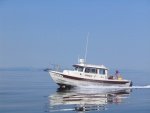teedidy
New member
- Joined
- Jul 7, 2017
- Messages
- 24
- Reaction score
- 0
- Hull Identification Number
- 2068017696
Hello again: So I am looking at the CD 25. I having spent countless hours on this forum I have came up with a new set of questions trying to understand a boat I don't yet have but really want. Knowing that the weak spot in the CD 25 (compared to deeper V boats) is wind waves and chop at 1 foot. I understand the best way to handle this is to trim the bow down, slow down and 12-18 mph is comfortable speed to travel. I live in Seattle area and currently have a slip in the Edmonds Marina (Puget Sound).
My Question is: "Where can I find monthly historical data for the average wave height in the Puget Sound"? As I look at the water from this last weekend. It looked flat, but while riding out there, it could have been 1 ft chop. For my current boat 1 ft isn't an issue (noise, safety, warmth, comfort ... are the issues (this list is really much longer)). I am trying to understand how often during the spring/summer/fall months I will need to slow down while out in the sound? My current boat doesn't plane well at 18 but I was able to ride comfortably at 22mph, the Admiral and I both think this will be fast enough.
Follow up question: If historical data is not available, could any with Puget Sound experience speak on the subject: Again I am out of Edmonds so my day trips (fishing) would usually start and end there.
Thank you for your time.
-Troy
My Question is: "Where can I find monthly historical data for the average wave height in the Puget Sound"? As I look at the water from this last weekend. It looked flat, but while riding out there, it could have been 1 ft chop. For my current boat 1 ft isn't an issue (noise, safety, warmth, comfort ... are the issues (this list is really much longer)). I am trying to understand how often during the spring/summer/fall months I will need to slow down while out in the sound? My current boat doesn't plane well at 18 but I was able to ride comfortably at 22mph, the Admiral and I both think this will be fast enough.
Follow up question: If historical data is not available, could any with Puget Sound experience speak on the subject: Again I am out of Edmonds so my day trips (fishing) would usually start and end there.
Thank you for your time.
-Troy



